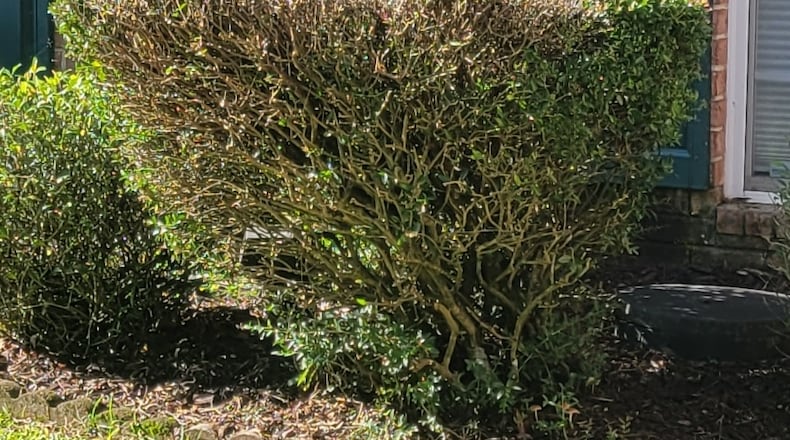Q: Over several years, my boxwoods have severely thinned out at the bottom. They were planted 20 years ago so I am wondering if they have outlived their life span. Can I do anything to fix them? Jamie Boeh, email
A: Your boxwoods were improperly pruned. The key to keeping a shrub full and leafy from bottom to top is to never cut the bottom limbs to be narrower than the top. When the top shades out the bottom of a shrub, it looks awful. Honestly, I think the best advice for you would be to pull out the shrubs, dig the soil thoroughly, add organic matter, and plant new ones. Meanwhile, I have great pruning instructions with photos and diagrams at bit.ly/GApruning.
Q: I have a steep hill in my backyard with cotoneaster on the top and Drift roses at the bottom. The weeds in the cotoneaster are terrible so last year I used a preemergent. That didn’t help and I am concerned that the preemergent ran down into the roses because they didn’t perform too good this year. Jimmy Glenn, Sandy Springs
A: Preemergent chemicals are carefully designed to quickly cling to soil particles and to stay in place, despite rainfall. After application, these products prevent seeds from germinating and they slowly decompose. Your preemergent didn’t run down the hill, so it didn’t harm your roses. To control weeds, your first job is to identify the weeds in your cotoneaster and then match the weed to the best method of control. Some weeds are impossible to control with chemicals in a shrub-covered area. Hand-pulling may be your only option. Take photos of the individual weeds to your local plant nursery when it’s not busy and ask employees to help.
Q: After treatment of my fig trees with Sevin liquid, how long should I wait before harvesting? Chris Walker, email
A: You’ll have to wait a long time since Sevin is not labeled for use on figs. And because the label is the law, I can’t tell you how to use it on your fig bush. In researching the answer to your question, I got a real shock. The Sevin that gardeners have used for decades as an insecticidal dust or liquid no longer contains carbaryl. The Sevin dust found now at garden centers contains bifenthrin, Sevin RTU contains lambda-cyhalothrin, and the active ingredient in Sevin lawn granules is zeta-cypermethrin. These ingredients are pyrethroid chemicals. Carbaryl is a carbamate. For various reasons, the company that owns the Sevin trademark has chosen to use pyrethroids in its consumer-grade products. Carbaryl is still available to professionals.
Email Walter at georgiagardener@yahoo.com. Listen to his occasional garden comments on “Green and Growing with Ashley Frasca” Saturday mornings on 95.5 WSB. Visit his website, www.walterreeves.com, or join his Facebook Page at bit.ly/georgiagardener, for his latest tips.
About the Author
The Latest
Featured
